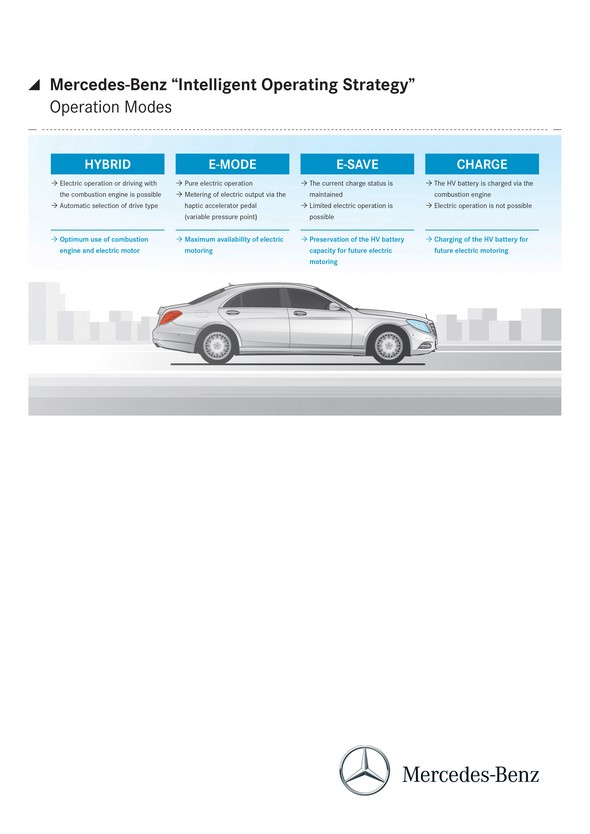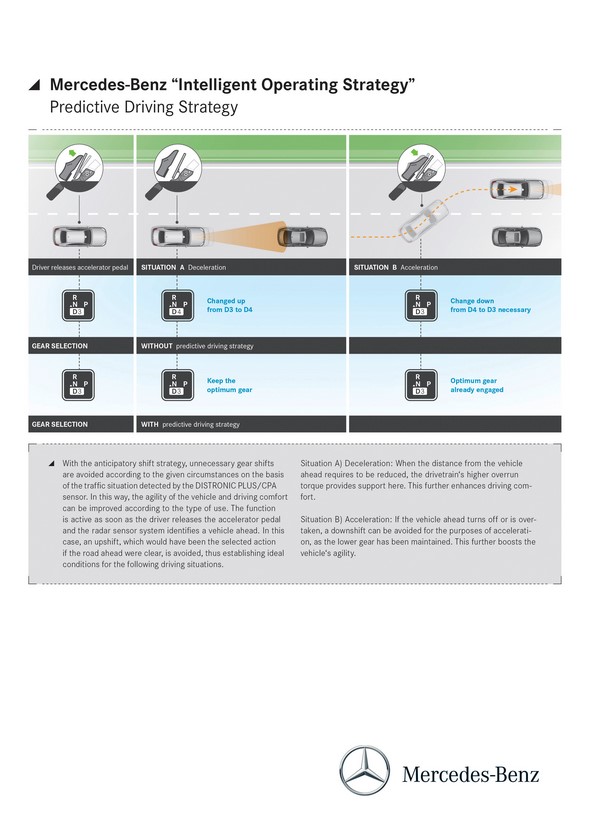First PLUG-IN HYBRID with a star: S 500 PLUG-IN HYBRID

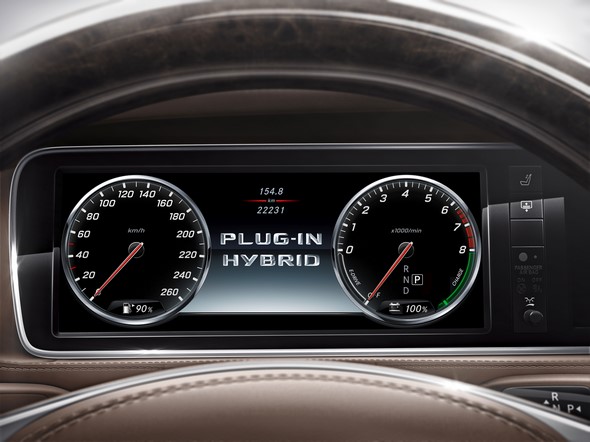
Efficiency = Performance
The new Mercedes-Benz S 500 PLUG-IN HYBRID blends an ultramodern hybrid drive configuration with the unique innovations and the luxurious equipment and appointments of the S-Class.
The luxury saloon with a long wheelbase impresses with exceptional dynamism and efficiency. Thanks to standard pre-entry climate control it also offers unique climate comfort.
The first certified three-litre luxury saloon in the world is a further milestone on the road to emission-free mobility. The first S 500 PLUG-IN HYBRID cars go to the customers this month.
“The S 500 PLUG-IN HYBRID is the first luxury saloon with the performance of a V8 and the fuel consumption of a compact model.
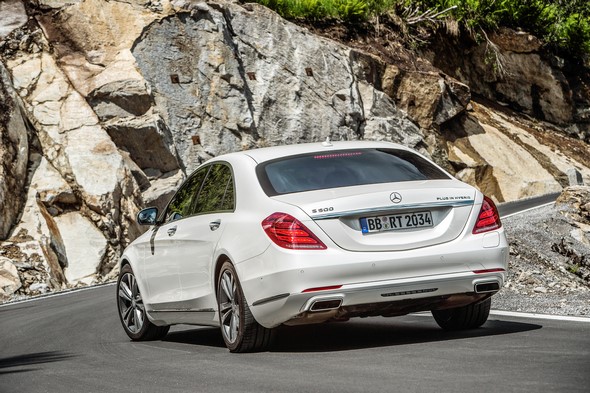
The greatest challenge in this is to translate efficiency into superior performance.
In this respect there is a highly interesting parallel with our successful Formula 1 racing car, which likewise has a turbocharged V6 engine and a high-tech hybrid drive,” says Prof. Dr. Thomas Weber, member of the Daimler Board of Management responsible for Group Research and Mercedes-Benz Cars Development.
“The new S 500 PLUG-IN HYBRID offers our customers the entire range of innovations that make our new S-Class so successful, and thanks to its intelligent operating strategy ensures outstanding driving pleasure and dynamism combined with the highest efficiency.
Moreover, it allows completely emission-free driving for up to 33 km,” adds Ola Källenius, Executive Vice President Sales and Marketing Mercedes-Benz Cars.
The Mercedes-Benz S 500 PLUG-IN HYBRID offers a system output of 325 kW and 650 Nm torque, sprints from 0 to 100 km/h in just 5.2 seconds and can drive up to 33 km purely electrically.
The certified consumption is 2.8 litres/100 km, which corresponds to 65 g CO2/km emissions. Key elements of this impressive output are the V6 biturbo and the intelligent hybrid drive.
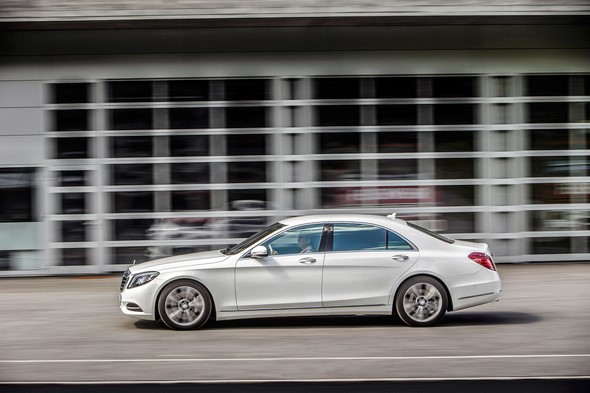
Following the S 400 HYBRID and S 300 BlueTEC HYBRID, the S 500 PLUG-IN HYBRID is the third hybrid model in the new S-Class.
Its new high-voltage lithium-ion battery with an energy content of 8.7 kWh can be externally recharged via the charging socket in the right side of the rear bumper.
All three hybrid S-Class models have environmental certificates. These document the models’ environmental performance from development through to recycling, across the entire lifecycle, and the performance is certified to internationally recognised standards by independent experts.
Regarding CO2 emissions the certificate of the S 500 PLUG-IN HYBRID states: “Over the entire lifecycle, comprising manufacture, use over 300,000 kilometres and recycling, clear advantages result compared with the S 500.

External charging with the European electricity mix can cut CO2 emissions by some 43 percent (35 tonnes). Through the use of renewably generated hydroelectricity a 56 percent reduction (46 tonnes) is possible.”
The hybrid transmission is based on the 7G-TRONIC PLUS 7-speed automatic transmission. The plug-in-hybrid system in the S-Class is based on the Mercedes-Benz parallel hybrid modular system.
The common system-specific feature is the additional clutch integrated between combustion engine and electric motor.
On the one hand, it decouples the combustion engine during purely electric operation; on the other hand, if the combustion engine is employed it affords the possibility to move off drawing on the performance of a wet start-up clutch.
The clutch then substitutes for the torque converter and requires no additional space owing to its complete integration in the torque converter housing.
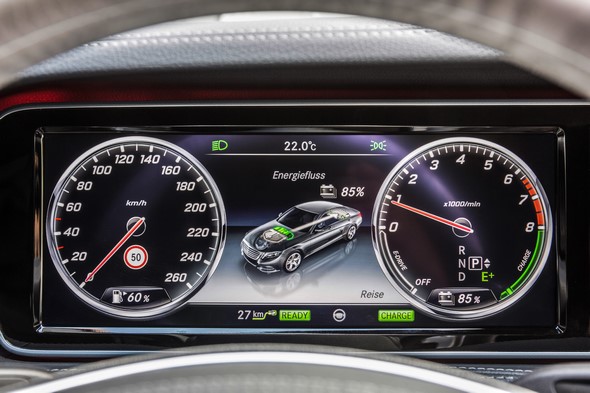
In order to strengthen the customers’ trust in the new, innovative plug-in drive technology, for the S 500 PLUG-IN HYBRID Mercedes-Benz is for the first time issuing a certificate and thus a promise to perform for the high-voltage battery and plug-in components (e.g. electric motor and power electronics).
This ensures that every technical malfunction within a period of six years after initial delivery or registration, or up to a mileage of 100,000 kilometres, is corrected by Mercedes-Benz.
Haptic accelerator pedal: support for the driver
Climb in, start, drive off and, as well as exemplary efficiency, on request experience via kickdown the special acceleration of the electric motor – this is how easy hybrid driving with the new S 500 PLUG-IN HYBRID is. For in everyday use it moves just as easily as any other automatic transmission car.
In the background, depending on the chosen operating mode the intelligent operating strategy automatically selects the ideal combination of internal combustion engine and electric motor and in so doing not only adapts its strategy according to the charge status of the battery; it also foresightedly adjusts it according to the traffic or route.

But anyone wanting to can also intervene manually and with the aid of four operating modes and three transmission modes regulate the hybrid interplay themselves.
What is known as the haptic accelerator pedal can signal via a double impulse when drivers should take their foot off the accelerator for sailing and recuperating.
During electric operation it can supply the driver with feedback on the switch-on point of the combustion engine.
The energy flow is shown in all operating states in the instrument cluster and in the central display, if this is selected by the customer.
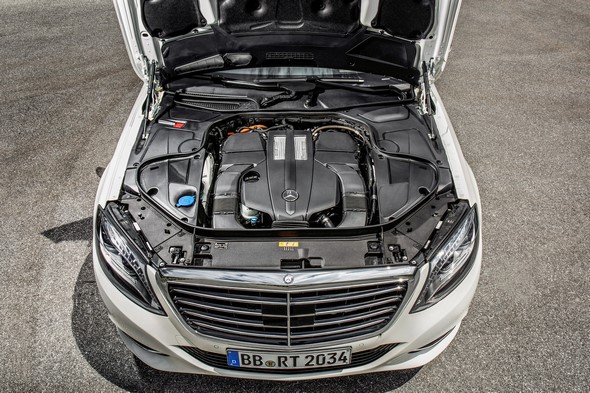
The technical data at a glance:
| Model | S 500 PLUG-IN HYBRID |
| Internal combustion engine: | |
| Number of cylinders/arrangement | 6/V |
| Mixture formation | High-pressure injection, 2 turbochargers |
| Displacement (cc) | 2996 |
| Rated output (kW/hp at rpm) | 245/333 at 5250-6000 |
| Rated torque (Nm at rpm) | 480 at 1600-4000 |
| Electric motor: | |
| Output (kW) | 85 |
| Torque (Nm) | 340 |
| System output (kW/hp) | 325/442 |
| System torque (Nm)1 | 650 |
| Consumption combined from (l/100 km)2 | 2.8 |
| CO2 emissions combined from (g/km)2 | 65 |
| Efficiency class | A+ |
| Electric range (km) | 33 |
| Charge time 20%-100% (400 V/16 A – 230 V/8 A)3 (h) | 2 – 4.1 |
| Acceleration 0-100 km/h (s) | 5.2 |
| Top speed (km/h)1 | 250 |
| Top speed electric (km/h)1 | 140 |
| Price (euros)4 | 108,944.50 |
1 Electronically limited, 2 In accordance with NEDC, 3 Charge time at 230 V/8 A e.g. at a commercially available socket. Through settings on the control element of the charging cable shorter charge times can be realised (standard setting: 8 A), provided that the power supply system is designed for this. Charge time at 400 V/16 A e.g. at a wallbox. The voltage and current ratings indicated refer to the power supply infrastructure and can be limited by the car.4 Sales price in Germany, incl. 19 percent VAT
Extensive standard equipment, extended pre-entry climate control
The standard equipment in the S 500 PLUG-IN HYBRID is extensive and offers a world premiere: the extended pre-entry climate control.
This is target value controlled. meaning that at the start of the journey the S-Class is air conditioned to the preset temperature if the driver has entered the departure time, via Mercedes connect me, for example.
This is possible due to the electrically driven refrigerant compressor and electric heating elements for the heated air.
In addition to this, when preheating it is not just the interior air but also the seats, steering wheel and armrests in the doors and centre console which are heated, and when cooling the seat ventilation is also activated if the respective optional extra is on board.
Also standard in the S 500 PLUG-IN HYBRID, which is only available with a long wheelbase, are for example LED High Performance headlamps and LED tail lights, leather upholstery, COMAND Online, touchpad, THERMOTRONIC automatic climate control plus seat heating also in the rear, Memory package for driver and front passenger, ambient lighting in seven colours and the air suspension AIRMATIC with continuously variable damping system.
The basic safety equipment includes PRE-SAFE®, COLLISION PREVENTION ASSIST PLUS (collision warning including Adaptive Brake Assist), ATTENTION ASSIST, PRE-SAFE® impulse, Crosswind Assist and Traffic Sign Assist (traffic sign recognition incl. wrong-way warning function and display of speed limits in the instrument cluster).
Over and above this a multitude of unique optional extras is available.
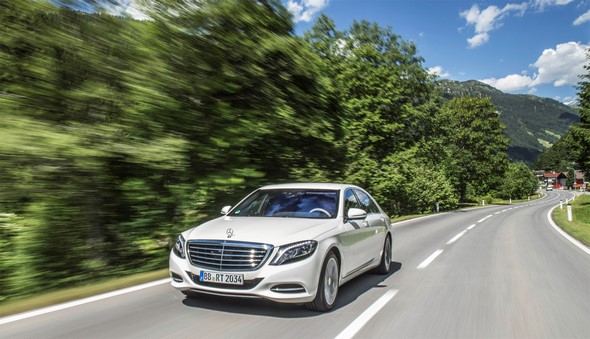
The Mercedes-Benz hybrid strategy: emphasis on plug-in drives
Following the S 400 HYBRID and S 300 BlueTEC HYBRID, the S 500 PLUG-IN HYBRID is the third hybrid model in the new S-Class.
The series production launch of this technology began at Mercedes-Benz in 2009. The company is up there among the leaders in the field of purely electric mobility, too. In the years to come the main emphasis will be on plug-in hybrids.
Hybrid drives, the combination of internal combustion engine and electric drive, help cut overall fuel consumption and boost performance, since the electric drive replaces or supports the combustion engine whenever the engine characteristics are unfavourable — normally in part-load operation when little power is required.
The largest potential for lowering the energy consumption of hybrid drive systems lies in maximising energy recovery during coasting and braking. Upon depressing the brake pedal the deceleration is initially effected by the electric motor and not by the disc brakes. The hybrid models of the new S-Class are the first to use a recuperative braking system of the second generation. It ensures an unnoticeable overlapping of the conventional mechanical brakes and the electric braking performance of the electric motor in generator mode.

Intelligent operating strategy
For efficient operation, foresighted driving, avoiding unnecessary braking and accelerating manoeuvres, has always been the best strategy.
This gains an all new importance in a hybrid model: braking manoeuvres serve not only deceleration, but can also be used to recuperate energy.
And the route has considerable influence on the most efficient charging and discharge of the high-voltage battery.
The intelligent operating strategy supports the driver comprehensively yet unobtrusively to achieve the most efficient driving style.
The control strategy, for example, seeks to ensure that the battery, if at all possible, is flat at the end of an uphill stretch so that it can be recharged going downhill.
Another key point is the requirement that urban areas be reached with a fully charged battery, if possible, so that the vehicle can be operated in stop-and-go traffic electrically – frequently and efficiently.
In the S 500 PLUG-IN HYBRID the energy management system basically covers these three areas:
- route-based: automatically or by way of four operating modes
- driver-based: by way of three transmission modes
- traffic-based: with the aid of radar.
Charging: power from a socket
The battery of the S 500 PLUG-IN HYBRID is safely fitted into the rear end of the S-Class to save space. An intelligent on-board charging system enables the battery to be charged at any conventional household power socket.
The supply of electricity to the car will be made even easier in future through inductive, cableless charging.
The S 500 PLUG-IN HYBRID stores electric energy in a lithium-ion battery on lithium-iron phosphate basis. The water-cooled energy storage unit has an overall capacity of 8.7 kWh, a total weight of 114 kg and a spatial volume of 96 litres.
To ensure highest levels of crash safety and dynamic handling and also maximum boot space, the housing is made of die-cast aluminium and the high-voltage battery is located in the rear of the vehicle above the rear axle.
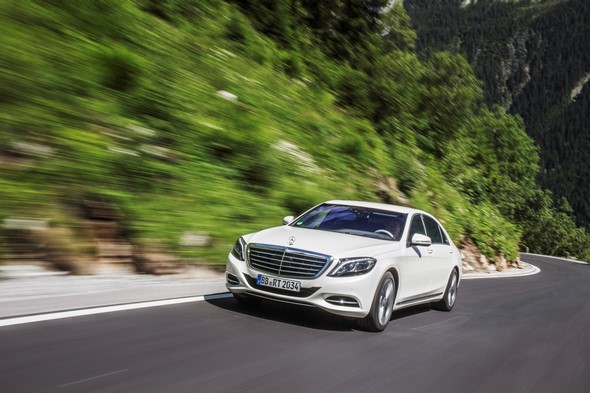
The space available there is put to optimal use, and the S 500 PLUG-IN HYBRID thus takes first place among the plug-in hybrids in terms of boot capacity (395 litres) and luggage compartment accessibility.
The high-voltage battery of the S 500 PLUG-IN HYBRID can be charged via external electricity mains using a 3.6 kW on-board charger.
The unit is permanently installed in the vehicle and charges single-phase up to 16 A. The connection for the charging cable is located under a flap in the rear bumper underneath the tail light on the right-hand side.
An automatic lock ensures that the cable cannot be separated from the vehicle by unauthorised persons. The new S-Class can be charged in two hours anywhere in the world, e.g. at a wallbox or a charging pole (400 V, 16 A).
Alternatively, charging via house connection is also possible, of course. Depending on the connection a charge time e.g. of two hours and 45 minutes can be attained (with 230 V and 13 A)[1].
Next step: S 500 PLUG-IN HYBRID – unplugged
One of the next steps on the way to the perfect electric vehicle and plug-in hybrid is cableless charging. Inductive battery charging will make the handling of electric vehicles and plug-in hybrids even more convenient.
Mercedes-Benz will test this “unplugged” technology with the S 500 PLUG-IN HYBRID in order to develop a genuine S-Class solution, in terms of comfort and ease of operation, for the charging of the high-voltage battery.
The history: leadership role in the premium segment
In 1982 Mercedes-Benz presented the first concept vehicle with hybrid drive – a two-cylinder horizontally opposed engine served to charge the battery.
A number of other experimental vehicles followed until in 2009 the world’s first standard-specification hybrid drive with lithium-ion battery debuted at Mercedes-Benz: this S 400 HYBRID was the most fuel-efficient petrol-powered luxury saloon for a long time. And the most successful hybrid in its segment: with around 20,000 buyers.
Based on the 7G-TRONIC PLUS automatic transmission the second-generation hybrid transmission evolved. It premiered in 2012 in the E 300 BlueTEC HYBRID, the first diesel hybrid in the premium segment worldwide.
By combining the efficiency of a diesel engine with the advantages of the hybrid drive, Mercedes-Benz set another milestone in the development of the automobile and advanced into consumption regions of 4 litres of diesel per 100 km in the luxury saloon segment.
With the C 300 BlueTEC HYBRID Mercedes-Benz has completed its hybrid portfolio below the luxury class. Moreover, in 2014 the B-Class Electric Drive, already on the market in the USA, will also become available in Europe to supplement the hybrid range.
Growing range: All current hybrid and electric drive vehicles from Mercedes-Benz Cars
- 2012: smart electric drive
- 2012: E 300 BlueTEC HYBRID
- 2012: E 400 HYBRID
- 2013: SLS AMG Coupé Electric Drive
- 2013: S 400 HYBRID
- 2013: S 300 BlueTEC HYBRID
- 2014: C 300 BlueTEC Hybrid
- 2014: B-Class Electric Drive
9/2014: S 500 PLUG-IN HYBRID
[1] The charge time ranges between 2 hours (400 V/16 A, e.g. at a wallbox) and 4.1 hours
(230 V/8 A, e.g. at a household power outlet).
Through settings on the control element of the charging cable, shorter charge times can be realised even with household power outlets, provided that the power supply system is designed for this.
The voltage and current ratings indicated refer to the power supply infrastructure and can be limited by the car. All charge times refer to the charging of the battery from 20% to 100%.
Energy management and operating system
Intelligent operating strategy
Climb in, start, drive off and, as well as exemplary efficiency, on request experience via kickdown the special acceleration of the electric motor – this is how easy hybrid driving with the new S 500 PLUG-IN HYBRID is.
For in everyday use it moves just as easily as any other automatic transmission car.
In the background, the intelligent operating strategy automatically selects the ideal combination of internal combustion engine and electric motor and in so doing not only adapts its strategy according to the charge status of the battery; in transmission mode E+ it also foresightedly adjusts it according to the traffic or route.
But anyone wanting to can also intervene manually and with the aid of four operating modes and three transmission modes regulate the hybrid interplay themselves.
Here, what is known as the haptic accelerator pedal supplies the driver with feedback on the switch-on point of the combustion engine or signals via a double impulse when they should take their foot off the accelerator for sailing and recuperating.
For efficient operation, foresighted driving, avoiding unnecessary braking and accelerating manoeuvres, has always been the best strategy.
This gains an all new importance in a hybrid model: braking manoeuvres serve not only deceleration, but can also be used to recuperate energy.
And the route has considerable influence on the most efficient charging and discharge of the high-voltage battery.
The intelligent operating strategy supports the driver comprehensively yet unobtrusively to achieve the most efficient driving style.
The control strategy, for example, seeks to ensure that the battery, if at all possible, is flat at the end of an uphill stretch so that it can be recharged going downhill.
Another key point is the requirement that urban areas be reached with a fully charged battery, if possible, so that the vehicle can be operated in stop-and-go traffic electrically – frequently and efficiently.

In the S 500 PLUG-IN HYBRID the intelligent operating strategy basically covers these three areas:
- route-based: automatically or by way of four operating modes
- driver-based: by way of three transmission modes
- traffic-based: with the aid of radar.
Four operating modes and three transmission modes
By means of operating mode and transmission mode switches next to the Controller on the centre console it is possible to switch between four operating modes.
A display in the middle of the instrument cluster tells which mode is currently selected. Here an overview of all four operating modes:
- Hybrid: As the name indicates, this standard mode offers hybrid driving, i.e. combines the operation of electric motor and combustion engine. The extent to which the electric motor is used to optimise consumption, or with boost function for especially dynamic acceleration, depends – apart from the customer’s driving style – on the battery charge status and the chosen transmission mode. Three transmission modes are available in this operating mode and can be activated using the transmission mode switch:
- Transmission mode E (Economy) is standard; the electric motor is used for both the benefit of efficiency and for driving pleasure. A power reserve is retained for the electric motor so that maximum additional thrust can be provided.
- In transmission mode E+ (Economy +) the objective is maximum fuel economy; all features of the intelligent operating strategy are active in E+. The greatest possible advantage is taken of the hybrid’s energy efficiency. For example, the vehicle sails as much as possible during coasting, while energy is increasingly recuperated only upon approaching another vehicle travelling ahead. Transmission mode E+ additionally makes use of radar technology – for details see the section below on “traffic-based operating strategy“.
- In transmission mode S (Sport) the sporty features of the drive system dominate. The transmission selects the shift points to benefit agility. This mode does without purely electric driving. The larger amount of electrical energy available because of this is used for the electrically supported boost function.
- E-mode: In this operating mode the S 500 PLUG-IN HYBRID runs purely electrically as much as possible. To ensure that the driver does not inadvertently engage the combustion engine by stepping on the accelerator, the haptic accelerator pedal with pressure point is automatically activated in this mode. The combustion engine engages only when the driver overcomes the pedal’s distinct pressure point.
- E-save: Here the charge status of the battery is preserved as it was when this operating mode was activated. For example, a fully charged battery can be held available if purely electric driving in a big city is on the agenda later. Electric driving in especially favourable situations, for instance after brief stops, is still permitted, but is metered so that the charge status does not fall below the value set by pressing the button.
- Charge: Here the high-voltage battery is charged during vehicle operation with the aid of the internal combustion engine. Electric driving and boost operation are completely dispensed with. Under optimal conditions a run-down high-voltage battery can be fully charged in just about half an hour. As soon as the high-voltage battery is fully charged, the system automatically switches to E-save
Route-based operating strategy
The route-based operating strategy takes the decision for the optimum sequence of operating modes for a route off the driver’s hands.
If the exact destination is known because the relevant data has been entered into the navigation system, charge and discharge of the high-voltage battery are controlled to ensure the optimal use of energy on the overall route, for as much as 1000 kilometres.
One objective is to use the battery’s energy content to drive uphill while recharging the battery through recuperation on the downhill stretch.
The system uses data from the COMAND Online navigation system to calculate the recuperation potential of the road ahead.
For example, the data provides information about the route profile and speed limits ahead in a one-metre grid for up to seven kilometres in advance.
If on the other hand the destination is not known, an assumed route is taken as a basis using likely turn-offs. In this case the system computes the probability depending on the road category.
If, for example, the hybrid vehicle is travelling on a motorway, the system assumes that it will remain on the motorway for the next seven kilometres.
Traffic-based operating strategy
In transmission mode E+, during electric operation the overrun torque is reduced to a minimum to enable sailing as often and as long as possible.
However, heavy braking after a long sailing phase, or premature sailing resulting in the need to restart the engine, are counterproductive.
Consequently, the system makes use of radar information in bumper-to-bumper traffic in order to get its bearings from the vehicle travelling ahead.
The distance from the vehicle ahead and the speed difference are recognised with the aid of radar sensors.
At exactly the moment when releasing the accelerator pedal would lead to optimally fuel-efficient “docking” onto the vehicle ahead, the driver receives a recommendation, in the form of a noticeable double impulse in the haptic accelerator pedal, to back off the accelerator.
If the driver accepts the recommendation and electric operation is available, the combustion engine is switched off and disconnected from the drive system.
The vehicle then sails. If the vehicle ahead reduces its speed or the gap becomes smaller for some other reason, radar-based overrun torque control sets in.
Increased recuperation by the electric motor correspondingly changes the gap to the vehicle ahead – and recovers energy.
Equipment and appointments
Extended pre-entry climate control
The S 500 PLUG-IN HYBRID blends an ultramodern hybrid drive configuration with the unique innovations and the luxurious equipment and appointments of the S-Class.
The luxury saloon with a long wheelbase not only displays exceptional dynamism and efficiency, it also offers unique climate comfort thanks to comprehensive, standard pre-entry climate control.
The standard equipment in the S 500 PLUG-IN HYBRID offers a world premiere in the extended pre-entry climate control.
Its functions are controlled by target values, meaning that at the start of the journey the S-Class is air conditioned to the preset temperature if the driver has entered the departure time, via Mercedes connect me, for example.
This is possible due to the electrically driven refrigerant compressor and electric heating elements for the heated air.
In addition to this, when preheating it is not just the interior air but also the seats, steering wheel and armrests in the doors and centre console which are heated, and when cooling the seat ventilation is also activated if the respective optional extra is on board.
The standard equipment of the S 500 PLUG-IN HYBRID, which is only available with a long wheelbase, is indeed comprehensive.
Standard features are for example LED High Performance headlamps and LED tail lights, leather upholstery, COMAND Online, touchpad, THERMOTRONIC automatic climate control plus seat heating also in the rear, Memory package for driver and front passenger, ambient lighting in seven colours and the air suspension AIRMATIC with continuously variable damping system.
The basic safety equipment includes PRE-SAFE®, COLLISION PREVENTION ASSIST PLUS (collision warning including Adaptive Brake Assist), ATTENTION ASSIST, PRE‑SAFE® impulse, Crosswind Assist and Traffic Sign Assist (traffic sign recognition incl. wrong-way warning function and display of speed limits in the instrument cluster).
Over and above this a multitude of unique optional extras is available – here is an extract:
- LED Intelligent Light System with variable light distribution for rural roads and motorways, active light function, cornering light function, enhanced fog light function and Adaptive Highbeam Assist Plus
- Head-up Display
- Driving Assistance package Plus including DISTRONIC PLUS with Steering Assist and Stop&Go Pilot, PRE-SAFE® Brake, BAS PLUS with Cross-Traffic Assist, Active Blind Spot Assist, Active Lane Keeping Assist and PRE-SAFE® PLUS, only in conjunction with Parking package including Active Parking Assist
- Night View Assist Plus with early detection of people and large animals in the dark, including spotlight function
- PRE-SAFE® rear package with illuminated seat belt buckle extenders, PRE-SAFE® belt tensioners and beltbags for outer rear seats
- Seat Comfort package for driver and front passenger, comprising: active multicontour seats in the front with dynamic handling function (seat side bolsters are each adjusted via an air chamber) and with ENERGIZING massage function (massage function via 14 air chambers in the seat backrest, massage heating panels in the spinal area), fast-acting seat heating Plus and adjustable lumbar support via three air chambers
- Rear seats electrically adjustable including Memory function comprising: three-seater bench seat with two electrically adjustable outer luxury seats, luxury head restraints with an additional cushion, front passenger seat operable from the rear, two ISOFIX child seat attachment points, two TopTether fastening points, armrest in the rear including double cup holder with wood trim and stowage space
- AIR-BALANCE package including ionisation, improved air filtering and fragrancing
- Warmth Comfort package comprising: heated armrest in the driver’s and front passenger door as well as in the centre console, heated armrest in the rear doors, heated armrest in the centre armrest in the rear in conjunction with electrically adjustable rear seats (optional extra), heated armrest in the business console in conjunction with First-Class rear suite (optional extra), buttons for heating the seats
and armrests in the door control panels in the doors, heated steering wheel - Panoramic sliding sunroof with convenience and automatic rain-sensor closing function, electric sunblind, obstruction sensor plus PRE‑SAFE® closing function
- Burmester® high-end 3D surround sound system with 24 loudspeakers, 24 amplifier channels and a total system output of 1540 watts
- Individual Entertainment System in the rear including two 25.4 cm (10″) displays on the backrest of the driver’s and front passenger seat, DVD player, two radio headphones and COMAND remote control
- TV receiver for digital television reception with support from, i.a., multichannel sound, EPG (electronic programme guide) and teletext
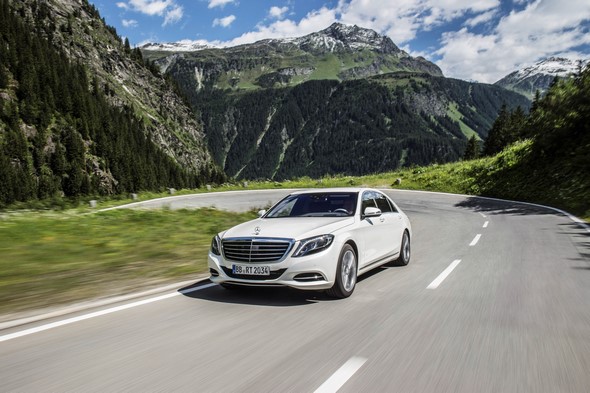
High-voltage battery and on-board charger
Power from a socket
The battery of the S 500 PLUG-IN HYBRID is safely fitted into the rear end of the S-Class to save space.
An intelligent on-board charging system enables the battery to be charged at any conventional household power socket. The supply of electricity to the car will be made even easier in future through inductive, cableless charging.
The S 500 PLUG-IN HYBRID stores electric energy in a lithium-ion battery on lithium-iron phosphate basis.
A modular design with 120 serially connected VDA single cells (22 Ah/cell) supplies rated voltage of 396 V, which can vary between 270 V and 430 V depending on the operating point and consequently is optimally suited for the electric drive.
The water-cooled energy storage unit has an overall capacity of 8.7 kWh, a total weight of 114 kg and a spatial volume of 96 litres.
An energy management system developed by Mercedes-Benz enables the best possible utilisation of the installed capacity, always makes the required output available and simultaneously protects battery life and availability.
To ensure highest levels of crash safety and dynamic handling and also maximum boot space, the housing is made of die-cast aluminium and the high-voltage battery is located in the rear of the vehicle above the rear axle.
The space available there is put to optimal use, and the S 500 PLUG-IN HYBRID thus takes first place among the plug-in hybrids in terms of boot capacity (395 litres) and luggage compartment accessibility.
Owing to the modular design of the battery components, further use of the battery system in other vehicle model series can be easily realised.
Battery charged in around two hours
The high-voltage battery of the S 500 PLUG-IN HYBRID can be charged via external electricity mains using a 3.6 kW on-board charger.
The unit is permanently installed in the vehicle and charges single-phase up to 16 A. The connection for the charging cable is located under a flap in the rear bumper underneath the tail light on the right-hand side.
An automatic lock ensures that the cable cannot be separated from the vehicle by unauthorised persons.
The new S-Class can be charged in two hours anywhere in the world, e.g. at a wallbox or a charging pole (400 V, 16 A).
Alternatively, charging via house connection is also possible, of course. Depending on the connection a charge time e.g. of two hours and 45 minutes can be attained (with 230 V and 13 A)[1].The operating data from the charge process and the available output are continuously transmitted to the vehicle’s energy management system, which then controls the charge process.
The on-board charger is located near the battery to ensure the optimal length of connecting cables and cooling water lines.
With its intelligent charge management the new S-Class supports the following functions:
- optimised charging making allowance for customer input, vehicle data and charging infrastructure
- reliable automatic calculation of the purchased energy quantity
- provision and reception of charge-relevant data.
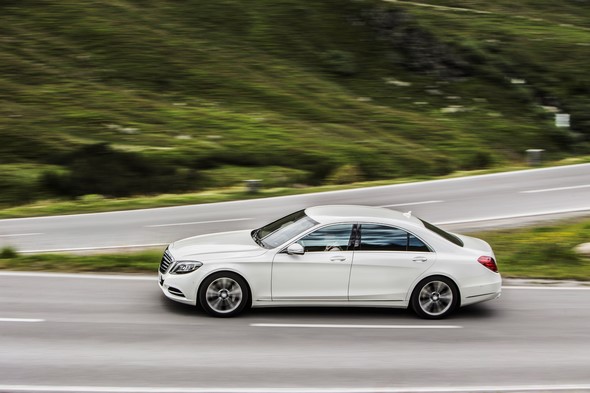
The S 500 PLUG-IN HYBRID is delivered as standard with a four-metre-long spiral charging cable for household power sockets, type E/F[2] (mode 2); on request an eight-metre-long smooth cable is available as an alternative.
Four other, partly spiral charging cables for industrial power sockets, public charging stations and wallboxes are optionally available.
Next step: S 500 PLUG-IN HYBRID – unplugged
One of the next steps on the way to the perfect electric vehicle and plug-in hybrid is cableless charging. Inductive battery charging makes the handling of electric vehicles and plug-in hybrids even more convenient.
Mercedes-Benz will try out this “unplugged” technology in a test fleet with the S 500 PLUG-IN HYBRID in order to develop a genuine S-Class solution, in terms of comfort and ease of operation, for the charging of the high-voltage battery.
The system is comprised of two components: a secondary coil plus a floor plate with integral primary coil which is placed underneath the car, for example on the garage floor.
The electric energy is transferred without contact, without a charging cable, with an output of 3.6 kW. The vehicle’s high-voltage battery thus can be charged efficiently, conveniently and safely with an efficiency factor of more than 90 percent.
[1] The charge time ranges between 2 hours (400 V/16 A, e.g. at a wallbox) and 4.1 hours (230 V/8 A, e.g. at a household power outlet).
Through settings on the control element of the charging cable, shorter charge times than 4.1 hours can be realised even with household power outlets, provided that the power supply system is designed for this.
The voltage and current ratings indicated refer to the power supply infrastructure and can be limited by the car. All charge times refer to the charging of the battery from 20% to 100%.
[2] Country-specific, depending on market conditions
Hybrid strategy
Leadership in the electrification of the premium segment
Following the S 400 HYBRID and S 300 BlueTEC HYBRID the S 500 PLUG‑IN HYBRID is the third hybrid model in the new S-class.
The series production launch of this technology began at Mercedes-Benz in 2009. In 2014 Mercedes-Benz will sell more hybrid automobiles than all other German manufacturers together.
The company is up there among the leaders in the field of purely electric mobility, too. In the years to come the main emphasis will be on plug-in hybrids.
In 1982 Mercedes-Benz presented the first concept vehicle with hybrid drive – a two-cylinder horizontally opposed engine served to charge the battery.
A number of other experimental vehicles followed until in 2009 the world’s first standard-specification hybrid drive with lithium-ion battery debuted at Mercedes-Benz: this S 400 HYBRID was the most fuel-efficient petrol-powered luxury saloon for a long time.
And the most successful hybrid in its segment: some 20,000 buyers worldwide opted for the S 400 HYBRID from the previous model series.
In addition to the parallel hybrid transmission of the first generation a power-split hybrid transmission was developed. The ML 450 HYBRID started out on the American market with this transmission in 2009.
Based on the 7G-TRONIC PLUS automatic transmission the second-generation hybrid transmission evolved. It premiered in 2012 in the E 300 BlueTEC HYBRID, the first diesel hybrid in the premium segment worldwide.
By combining the efficiency of a diesel engine with the advantages of the hybrid drive, Mercedes-Benz set another milestone in the development of the automobile and advanced into consumption regions of 4 litres of diesel per 100 km in the luxury saloon segment.
Again in 2012, in the E 400 HYBRID, and in 2013 in the new S 400 HYBRID, Mercedes-Benz carried on the tradition of hybrids with six-cylinder direct injection petrol engines, and in 2013 also put the second diesel hybrid, the S 300 BlueTEC HYBRID, on the market.
With the C 300 BlueTEC HYBRID Mercedes-Benz has completed its hybrid portfolio below the luxury class. In the years to come a number of other plug-in hybrid vehicles will follow.
Pioneer also in the field of purely electric mobility
With the smart fortwo electric drive and the Mercedes-Benz SLS AMG Coupé Electric Drive, Daimler AG is a pioneer in the field of purely electric mobility as well.
Since 2014 the B-Class Electric Drive has also been on the market. Quiet, locally emission-free motoring is ensured by an electric motor generating 130 kW.
Typically for an electric drive system, this develops its maximum torque of more than 340 newton metres from the very first touch of the accelerator.
This is approximately equivalent to the torque from a modern three-litre naturally aspirated petrol engine. The result is noticeably powerful acceleration from stationary.
For the standard sprint from zero to 100 km/h, too, the electrically driven B-Class requires only 7.9 seconds.
Effortlessly superior driveability and exhilarating driving pleasure with a high level of dynamism are thus guaranteed in every situation.
In the interests of optimising the range, the top speed is electronically limited to 160 km/h. Depending on the driving cycle, the vehicle has a range of around 200 kilometres.
The electric vehicles and hybrids share the electric drive components from the Mercedes-Benz modular system.
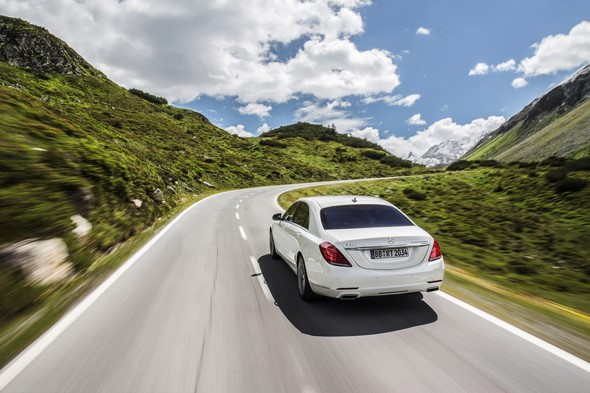
Current range of hybrids in the luxury class
With the new S-Class Mercedes-Benz now continues its comprehensive hybrid offensive. The S 400 HYBRID and S 300 BlueTEC HYBRID are two further hybrids, in addition to the S 500 PLUG-IN HYBRID:
- The S 400 HYBRID burns just 6.3 litres of fuel per 100 kilometres in the NEDC cycle (combined). This represents a reduction by 20 percent over the predecessor. CO2 emissions of 147 grams per kilometre is also a record in this vehicle segment. These exemplary figures go hand in hand with outstanding performance potential: the petrol engine develops 225 kW (306 hp), while the electric motor adds another 20 kW (27 hp). The torque of the combustion engine is 370 Nm plus 250 Nm from the electric motor.
- In the S 300 BlueTEC HYBRID Mercedes-Benz has combined the 2.2‑litre four-cylinder diesel engine developing 150 kW (204 hp) with the powerful hybrid module developing 20 kW (27 hp). The peak torque of 500 Nm produced by the combustion engine is overlaid by the 250 Nm of peak torque produced by the electric motor. The S 300 BlueTEC HYBRID makes do with 4.4 litres per 100 km in the combined cycle (CO2: 115 g/km), and complies with the criteria for energy efficiency class A+. Consequently, Mercedes-Benz has nearly cut fuel consumption in the 150-kW performance class by half over the course of ten years.
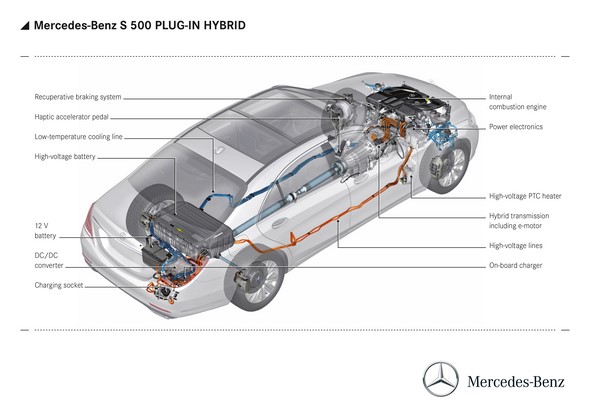
All hybrid drive milestones at a glance:
Research vehicles
- 1982: Mercedes-Benz concept employs a two-cylinder horizontally opposed engine
- 1993: Mercedes-Benz “Taxi Hybrid” as first parallel hybrid. A
C-Class combines a 55 kW (75 hp) four-cylinder diesel engine with an electric motor delivering 130 Nm and 20 kW (27 hp) - 2001: smart fortwo cdi. A 20 kW (27 hp) electric motor together with the 30 kW (41 hp) three-cylinder diesel engine forms a truly space-saving unit
- 2002: Mercedes-Benz Unimog “E-Drive”
- 2002: Mercedes-Benz M-Class “HyPer”. ML 270 CDI with a 120 kW (163 hp) common-rail diesel engine and automated manual transmission. It features an electric motor with an output of 45 kW (61 hp) and high torque, installed between the engine and the transmission
- 2003: Mercedes-Benz F 500 Mind. The four-litre V8 diesel power plant delivers 178 kW (242 hp) and 560 Nm. The electric motor adds another 48 kW (65 hp) and 300 Nm. The company showed the same drive system in the Mercedes-Benz Vision Grand Sports Tourer vehicle study
- 2004: Mercedes-Benz Sprinter with plug-in-hybrid drive
- 2005: Mercedes-Benz S-Class “Hybrid”. Eight-cylinder diesel engine developing 191 kW (260 hp) and 560 Nm, plus two electric motors with a total output of 50 kW (68 hp)
- 2005: smart crosstown. Hybrid with three-cylinder petrol engine (45 kW) and electric motor (23 kW)
- 2009: Concept BlueZERO in three versions: as electric car (E-CELL),
as fuel cell-powered vehicle (F-CELL) and with range extender (E-CELL PLUS)
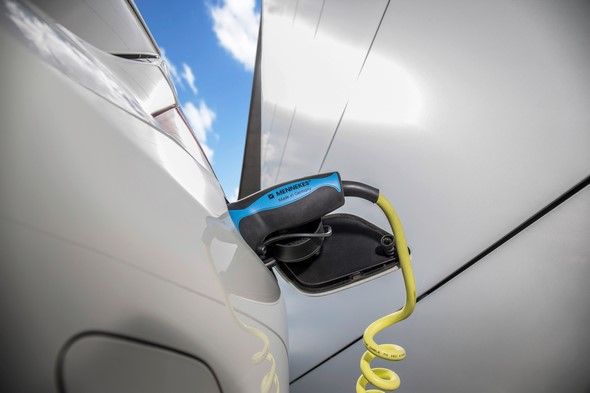
Production cars (hybrid and electric drive)
- 2009: S 400 HYBRID (20,000 buyers worldwide)
- 2009: ML 450 HYBRID
- 2012: smart electric drive
- 2012: E 300 BlueTEC HYBRID
- 2012: E 400 HYBRID
- 2013: SLS AMG Coupé Electric Drive
- 2013: S 400 HYBRID
- 2013: S 300 BlueTEC HYBRID
- 2014: C 300 BlueTEC Hybrid
- 2014: B-Class Electric Drive
9/2014: S 500 PLUG-IN HYBRID





